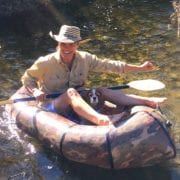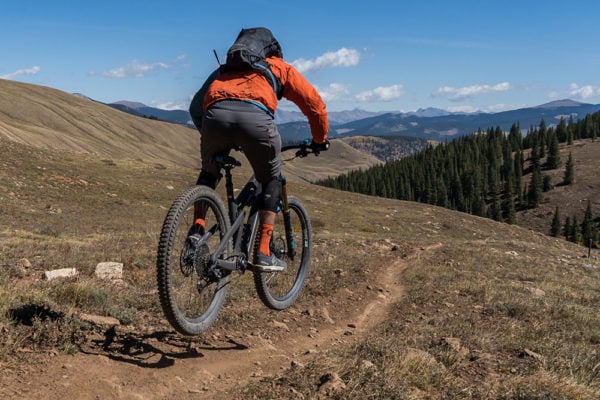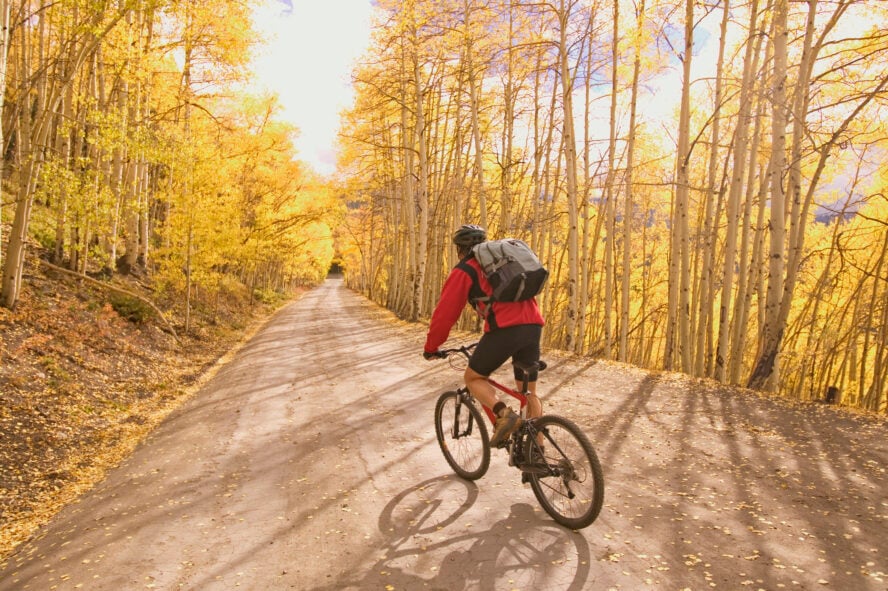Cleaved in two by the Rocky Mountains, Colorado offers fantastic ride diversity. In the western half around Fruita, you’ll find desert terrain featuring plenty of dry singletrack early in the season. On the eastern plains, you’ll find some of the best mountain biking trails in Colorado too. But it’s the heart of this landlocked state, specifically near the Front Range and Central Rockies, that offers the majority of the staggering 8,000-plus miles of tracks, with the famed mountain town of Crested Butte home to 750 miles of those. It’s so vast and varied you’ll feel like you’re mountain biking in New Zealand.
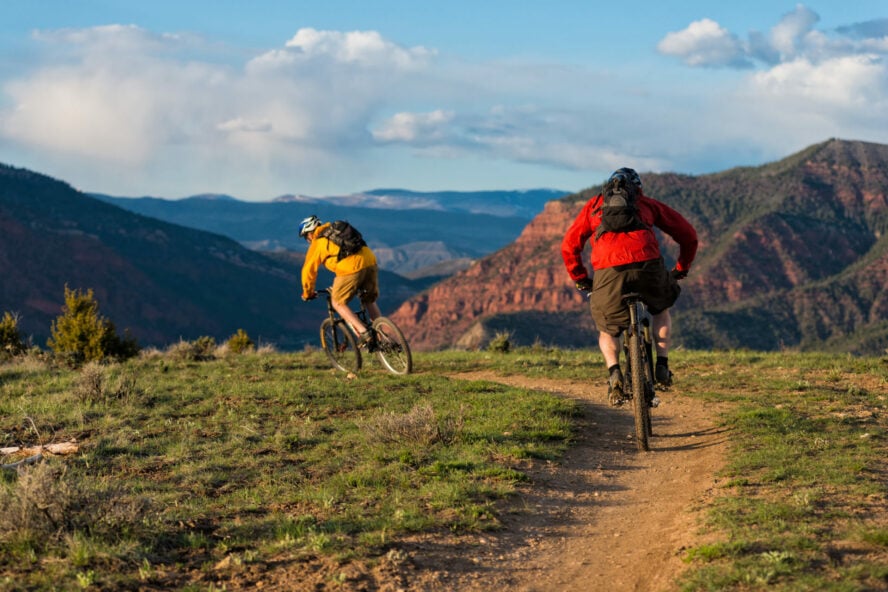
Traveling to the birthplace of mountain biking in Colorado
Skiing and hiking might first come to mind when you think of things to do in Colorado, but mountain biking has a storied history thanks to the locals who helped craft a new outdoor sport. Along with early riders in California and British Columbia, Crested Butte played a seminal role in mountain biking’s beginnings.
It was an avid cycling community back in the 1970s who took it upon themselves to tinker with clunkers and road bikes to find better alternatives to “forearm suspension” as they rode over rugged mountain and off-road terrain.
Where is the best mountain biking in Colorado?
I might be biased as an Aspen local, but the Rockies and the Western Slope offer some of the best mountain bike trips in the state. Resorts looking to accommodate off-season recreators have upped their game, creating miles of trails, world-class bike parks and incredible downhill accessibility. Snowmass, Crested Butte, Breckenridge and Vail resorts developed to craft thrilling trails for a range of skill levels and objectives.
If you want to ride focused on fun or little ones, Breckenridge and Snowmass provide some of Colorado’s best mountain biking for beginners and are a great place to head out on a guided mountain biking tour if you’re new to the sport. Snowmass Bike Park also features a quick lift to get your adrenaline going. The Front Range shouldn’t be overlooked, however, for the ease of access, variety for skill levels and downhill trails offering plenty of bragging rights.
To mix metaphors, you gotta earn your turns to get to the best. We’ll detail some of the best mountain bike trails in Colorado.
1. Crested Butte
Behold the glory of Crested Butte’s over 700 miles of singletrack. A former coal mining town about 200 miles from Denver, Crested Butte sits at 8,850-feet elevation and is considered the cradle of modern mountain biking.
The story goes that Crested Butte’s streets didn’t get paved until the early 1980s. Local gearheads created heavy but durable bikes with knobby, fat tires to navigate the pothole-ridden streets caused by the extreme weather changes in the mountains. These early mountain bikes became the preferred method of travel, and a new obsession was born.
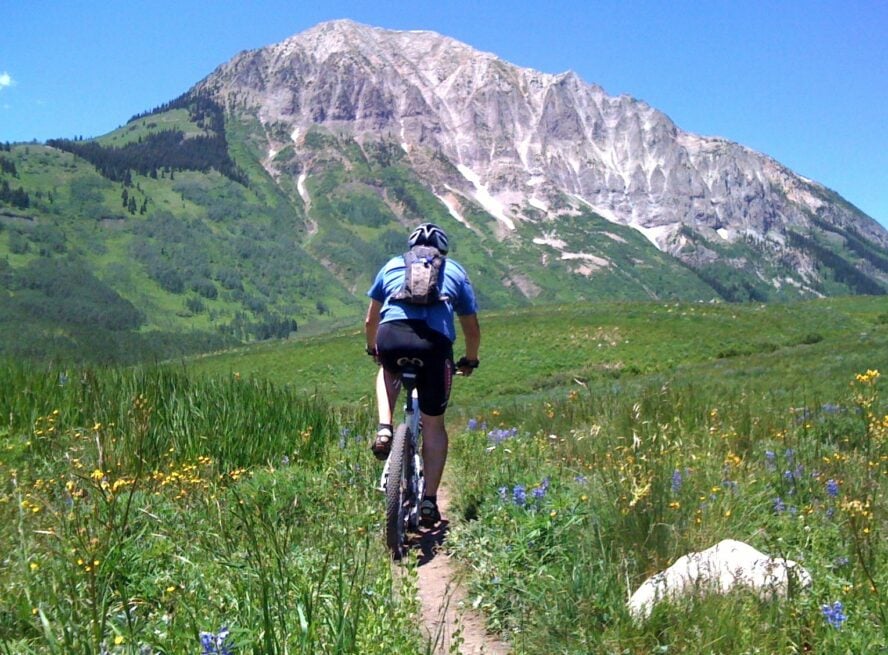
Quick guide to Crested Butte mountain biking
In 1976, Crested Butte riders opened the first mountain bike shop in the United States. The local obsession didn’t stay hidden in the mountains. Starting in 1976, a bunch of these burly riding locals decided to ride the 12,075-foot Pearl Pass, a 40-mile mule pass, and visit their neighbors in Aspen. The Pearl Pass Tour is now held every September. Crested Butte is also home to the country’s first mountain biking club, the Crested Butte Mountain Bike Association, established in 1983.
With 2,500 people, this bike-loving mountain town is home to an estimated 3,500 bikes and seven bike shops. Crested Butte is also surrounded by an abundance of single-track trails and massive cross-country tracks to ride. Spend the day exploring its MTB trails or ramp up your adventure with a multi-day tour. Crested Butte delivers the great outdoors and incredible access to a range of cross-country (XC) mountain biking trails. You might just want to stay year-round because the terrain offers plenty of activity.
Best Crested Butte Mountain Biking Trails
The beauty of the terrain here is what sets it apart from other mountain biking destinations. Wildflower-covered valleys lead into thick groves of aspens before climbing up, out and into the alpine before there’s a descent of sheer handlebar gripping madness — all good stuff.
Start at Evolution Bike Park for flows, turns and jumps
For beginners, the Evolution Bike Park at Crested Butte Mountain Resort is ideal to check out if you want a day to refine your skills. You can get acclimated to the altitude, learn the terrain, and find plenty of turns to keep you on your toes.
Here, you can find 25 miles of trails open to mountain bikes. Five of those trails have been built for downhill mountain biking, staying closed to uphill riders and all other trail users allowing for uninterrupted descents. If you want a fast, flowy jump trail, Timeline is bound to be the most popular trail on the mountain.
Try Trail 401 for Crested Buttes’ best alpine mountain biking
Considered by many to be one of the finest bike rides Colorado has to offer, the 401 loop offers up some of the best in alpine mountain biking. It’s just over 14 miles at a high enough altitude to give you pause.
The views of the Elk Range, with miles of aspen groves and clear alpine lakes make it a seasonal favorite. You’ll gain over 2,200 feet in your ascent, but the downhill through wildflower fields make every foot in elevation gain worth it. While some say there are better trails in the area, I recommend this is a must ride for everyone. At least once.
Doctor Park singletrack is seven miles of flowy descent
This trail is a local favorite and great ride if you’re in Crested Butte. This ride can also be shuttled if you’re looking to shave off about 1,500 feet of elevation gain and about eight miles of a slog up a dirt road. If you choose to omit the first part, never fear, the ride itself truly begins as the trail begins its approximately seven miles of descent. The singletrack on the descent is smooth with plenty of technical areas and rocks, getting rockier and looser the further down you go. It’s when the trail gets smooth that the fun really begins. Almost three miles of seven in the descent are mind-blowing, as flowy as the best of Northeast Kingdom mountain biking, and truly second to none.
Combine four trails for a rewarding switchback descent
Ok. So not a single trail, but a stunning combination of four will do just fine. This route calls for taking Reno to Flag to Bear then Deadman’s Gulch for a thrilling mountain bike ride. What this combo offers are three uphill ascents for a total elevation gain of 3,326 feet, three rewarding descents and about 30 hold-on-to-your-handlebar switchbacks on the last go. The ride boasts terrain in deep timber, open meadows that feel like mountain biking in France, and a couple of creeks, all in quiet Crested Butte serenity.
Wildflower-covered valleys lead into thick groves of aspens before climbing up, out and into the alpine before there’s a descent of sheer handlebar gripping madness – all good stuff.
Crested Butte - Good to Know
Beginner to advanced
All-mountain, cross-country, downhill
May to October
Campgrounds: Oh Be Joyful, Cement Creek;
McGill’s At Crested Butte, Momo’s, Montanya Rum for a post-ride cocktail
2. Breckenridge
Thanks to 800 miles of tracks, Breckenridge mountain biking trails offer something for all skills from first time riders to challenging routes. This quaint resort town will also deliver on wide berms, switchbacks, and miles of singletracks. Similar to Breckenridge’s skiing options, beginner riders will delight in this outdoor playground.
If you’re ready for it, you won’t be lacking for challenging riding. In fact, you can take in the challenging but iconic 33-mile section of the singletrack on the Colorado Trail dropping you in Breck.
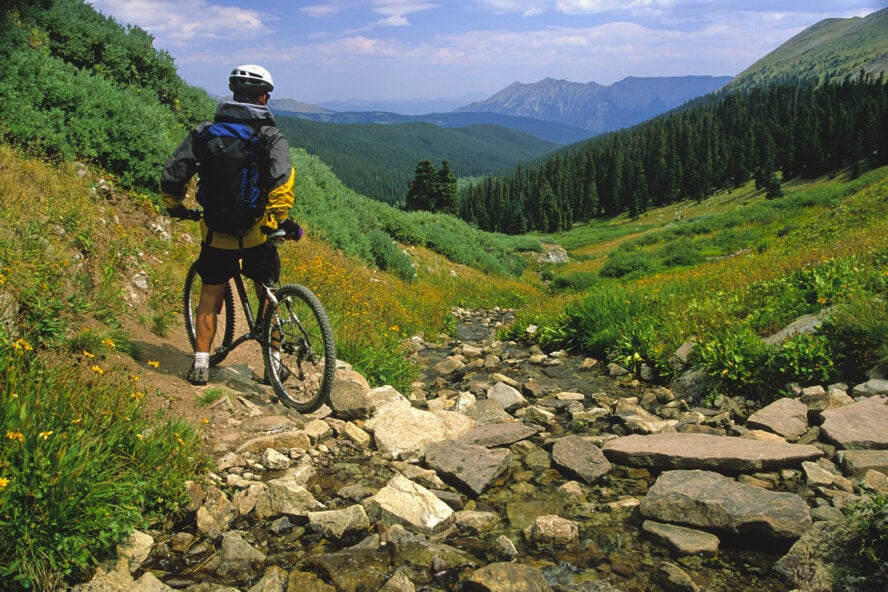
Best Breckenridge Mountain Biking Trails
Child-friendly, charming, and challenging when it wants to be—Breck brings the whole package. It’s a bikers’ town through and through, and it’s got the rides to prove it it.
Abundance of beginner mountain biking trails
Another thing that’s not to be missed while mountain biking here is the Wellington Bike Park. For kid-friendly riding, it’s the place to be. This is a free entry area that has a Strider track, three flow trails, and a skills area where you can work on your jumps. You can get all of this without even leaving town.
Speaking of town, Breckenridge is a designated Gold Level Bicycle Friendly Community, deemed such by the League of American Bicyclists — this is a testament to the area’s facilities and dedication to supporting the two-wheeled community — fat-tired or not.
Peaks Trail for some intermediate aerobics
Starting out at 10,500 feet, Peaks Trail is a Colorado classic and favorite of both locals and visitors alike. Peaks is the perfect blend of adrenaline downhills and relaxed cruising. This route can be ridden as an out and back, with plenty of roots, climbs and descents.
Traveling from Breckenridge to Frisco sets you up for some fairly moderate climbing until you plateau and hit the 1,000 feet for your ascent. If you ride this trail both ways, make sure you’re rested up before the journey, as it’s pretty much all up hill. Keep an eye out for hikers when you get close to either town because it’s a popular walkway. If the return-trip climb isn’t appealing, you can always ride back on the paved Blue River Bikeway to get back to Breckenridge.
Breck’s section of Colorado Trail: Kenosha Pass to Breckenridge
Technically this 33-mile segment of the 547-mile IMBA EPIC Colorado Trail, signifying true backcountry riding in a remote setting. The all single-track trail begins in nearby Kenosha and ends in Breckenridge. You’ll be spending most of this ride at higher elevations, so plan accordingly and bring extra water and food.
Starting from Kenosha, you’ll begin with a decent climb to an aspen clearing and views of the Como Valley. After your first descent, an even greater climb awaits, bringing you to a (literal) breathtaking 12,000 feet.
I’ll admit this route is definitely brutal and potentially energy sapping, but this section of the Colorado Trail is worth every foot. Once you’ve broken treeline, the views are so vast and scenic you’ll feel like you’re mountain biking in Croatia. While the greatest elevation may be behind you at this point, get ready for three more ascents to conquer before you hit the Gold Hill trailhead just north of Breckenridge on Highway 9.
Gold Run Road’s gravel trail is perfect for beginners
Beginners can gain their footing on this 3.6-mile one way trail. If you’re looking for a quick ride through the forest, Gold Run Road is the fun, low-pressure trail for you. This route is also an excellent way to link to plenty of other trails within the Golden Horseshoe network. This doable gravel path travels through aspen groves — a must-do in fall. It’s so straight forward, first timers on a bike could do it.
Cross the Continental Divide on historic Boreas Pass Road
I recommend this trail for its high-altitude panoramas and historic sights without the grind of Boreas Pass. Despite its length, Boreas Pass is more of a beginner’s trail and worth riding for the single-track downhill until the end.
The ride starts on Boreas Pass Road, a 17.4-mile out and back passing glimpses of historic markers such as a water tank and old mines. Spoiler alert: you’ll have to share with other vehicles. To take it to the next level, you can connect with Baker’s Tank, after the Pass. You’ll get some steep and challenging terrain to climb before heading down through a beautiful pine forest. Keeping with the flow, you shoot back out upon the paved section of Boreas Pass road.
Breckenridge is a designated Gold Level Bicycle Friendly Community, deemed such by the League of American Bicyclists – this is a testament to the area’s facilities and dedication to supporting the two-wheeled community – fat-tired or not.
Breckenridge - Good to Know
Beginner to advance
Singletrack, cross-country, all-mountain
Late June to September
Gold Run Road
Sancho Tacos and Tequila, Mi Casa Mexican Restaurant and Cantina, Little Bar & Grilled
3. Colorado Springs
Colorado Springs is emerging as a must for Colorado mountain biking due to starter trails in its city center building up to gnarly backcountry tracks. I’d be remiss to mention the downhill trails off the summit of the 14,110-foot Pikes Peak mountain in nearby Manitou Springs.
Yes, really. Pikes Peak is one of the more famed 14ers in the state, aka the local obsession with Colorado’s 58 mountains stretching above 14,000-feet elevation. You also won’t run out of entertainment. Colorado Springs is home to the Garden of the Gods, with its 300-foot towering sandstone rock formations, and a bit of riding through sage brush.
The city on the southern edge of the Front Range also offers a sneak route to Monarch Crest Trail, all through some worthwhile pit stops. As is the case with Bellingham mountain biking, most of the best trails are phenomenally accessible, and downing two or more in a single day is very doable.
I’ve compiled a few standout trails for anyone looking to get acquainted with this Front Range mountain biking gem.
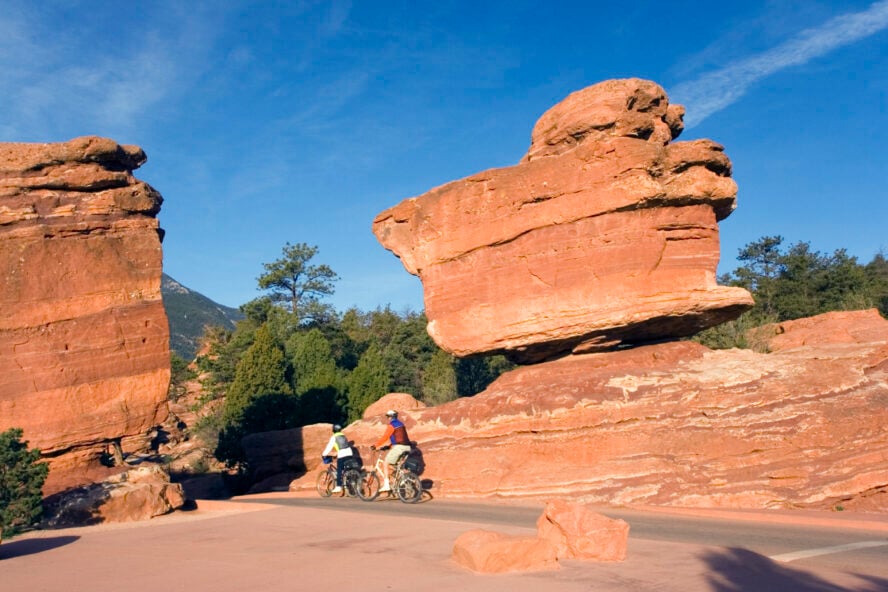
Best Colorado Springs Mountain Biking Trails
Bike through the gateway to the Front Range and enter a whole new world of adventure. Cruises, chutes, and even some leaps of faith await in an area that evokes the best mountain bike trails in Sedona.
Ride the “Secret Garden of the Gods” at Red Rock Canyon Open Space
For beginners, and if you’re looking for a scenic cruise, I’d recommend a scenic Ute mountain bike trail in Garden of the Gods. You can also skip the crowds and head to the alternative Red Rock Canyon Open Space.
The reclaimed space (read: former landfill) is home to 15-miles of intermediate trails boasting some nice vantage points of the Morrison Formation, one of the highest concentrations of dinosaur bones in the country. Red Rock Canyon might not be the sexiest of the Colorado Springs mountain biking trails, but you will find satisfying singletrack through sandstone hogbacks, and rock formations that will make you feel like you’re mountain biking in Utah.
Barr Trail is one the best ways to bike down Pikes Peak
Bagging Pikes Peak is one of those rides worth bragging about. The 26-mile round-trip Barr Trail navigates mountain bikers up to the top of Pikes Peak. If you’re looking for a challenge, then you’ll love Barr Trail, but it’s only for expert riders.
You also shuttle to the top for a point-to-point pedal including a mere 129-foot climb to experience a 8,175-foot descent. I recommend the latter, but it’s your journey. Either way, you will have some of the most inspiring views of the Colorado Springs area.
Starting from the top, you’ll encounter 32 boulder-filled switchbacks called “The Golden Stairs.” You’ll need to be ready to hike-a-bike, as in carry your bike, but for obvious reasons even that isn’t a walk in the park. Once you reach You next reach the namesake Barr Camp, you’re about halfway down and onto the easier sections. At least it’ll be rideable from here!
Plummet down Pikes Peak for the literal ride of your life
Pikes Peak Plummet links several fun trails together for a 26-mile ride from the summit back to Colorado Springs. You also get 7,120 feet of descent. Unless you want a really long trip, this route is best serviced by shuttling up Pikes Peak to the Elk Park Trailhead.
This is a self-supported trail so prepare to be on remote trails. It can also be guided if the thought of being at 14,000 feet without cell service is intimidating — and should be taken seriously if you’re new to long-distance, high-alpine treks like the ones commonly found when mountain biking in Europe.
This trail starts technical before reaching the Barr Trail Camp intersection. You’ll find some adrenaline-fueled jumps on the way to Lake Moraine Trail when you reach true isolation. You connect to four other trails to reach the famous Captain Jacks for an essential Colorado downhill mountain biking experience. The Chutes is also a super fun section taking you back onto singletrack, high berms and a grat flow.
Elk Park is the Pikes Peak alternative without the foot traffic
While riding from the summit of Pikes Peak via Barr Trail is an option, getting there and back can be difficult with hikers and trail conditions alike. The Elk Park trail is a solid alternative to Barr and its contingencies. Elk Park doesn’t include Pikes’ 14,115-foot summit, but rather the starting point is a “modest” 11,835.
Depending on how you plan your day, you can utilize existing roads and trails and extend your ride downwards and incorporate the much loved Captain Jacks. Regardless, Elk Creek has plenty of technical challenges on hand, along with creeks, views, gravel and some smooth, smooth dirt.
Palmer Park Loop features urban tracks without technicality
This list wouldn’t be complete without a loop in Palmer Park. While you’re here, remember that there are horses, runners, kids and hikers here too, so be mindful of your speed and others. This ride isn’t technical, but it’s here because it showcases the city’s talent of incorporating all kinds of public activities with public land in an urban setting. This is a 12-mile loop that takes in all the park has to offer and it’s worth every pedal.
Colorado Springs is the up-and-coming Colorado mountain biking spot for its variety, accessibility and white-knuckly descents from the state’s most famous 14er.
Colorado Springs - Good to Know
Beginner to advanced
Singtrack, downhill
Late May to October
Ute Trail
Try Lone Duck Campground in Cascade to be close to Pikes Peak
4. Snowmass
When discussing tire-burning downhills, a lot of people talk about the mountain biking in North Carolina. However, Snowmass, Snowmass Bike Park to be exact, is my personal favorite. Granted, I might be partial as a resident in the valley. Snowmass Village is just 12 miles from Aspen, connected by a network of high-alpine trails catering to intermediates to teeth-grinding black diamond riding.
Aspen might get all the glory, but Snowmass really packs in the year-round thrills. In fact, the Snowmass area is host to over 50 miles of mountain biking trails, including lift-service downhill biking trails as good as the ones you’ll find mountain biking Park City, featuring a 2,893-foot descent from the top of the Elk Camp Chairlift.
Although Valhalla at Snowmass bike park has a crowd-pleasing reputation, you can always go classic with a XC ride or cruise through Verde Mountain Bike Trail beginner freeride if there are little bombers in tow — or you just want to ease into your ride.
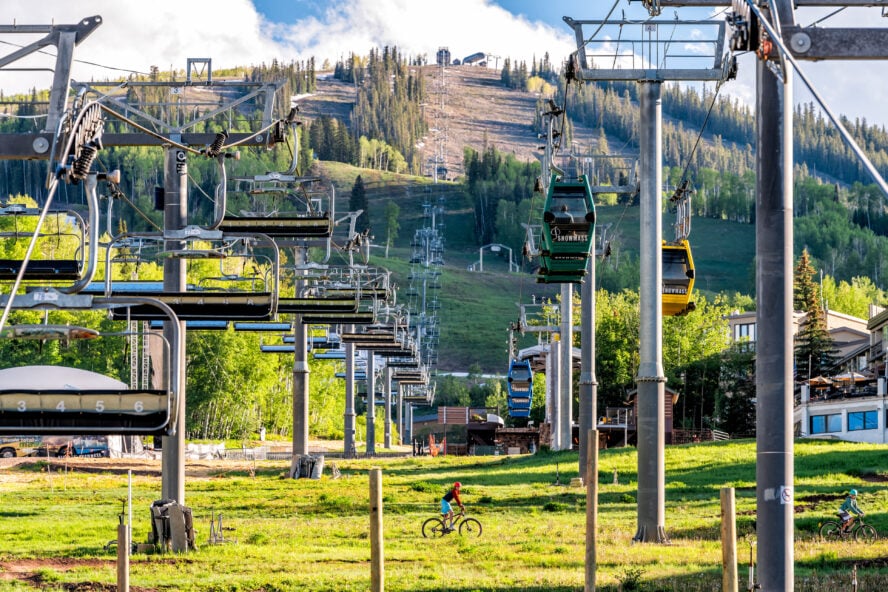
Best Snowmass Mountain Biking Trails
Covered by excellent lift service, you’ll be zipping from singletrack to singletrack, checking off runs at a moment’s notice. Get ready for some of the greatest alpine ridesin the Centennial State.
Valhalla: major descent riding at Snowmass Bike Park
Valhalla is Snowmass’ first freeride trail, named after Norse Mythology, at Snowmass Bike Park. Aimed at intermediate to advanced riders, the 2.8 mile course snakes through aspen forests and a drop of 1,400 vertical feet back to base village. I got hooked on the big bank turns, noncommittal jumps and expertly crafted berms on this flowy trail. You can also run this all day going bigger with each run over strategic jumps, set ups and wooden features to keep you alert.
Rim Trail Loop: a singletrack classic
The Rim Trail in Snowmass is a beloved 11-mile singletrack that’s been around for decades and adopted by MTB riders. Riding past Aspen groves on contoured trails is really about as classic as it gets here in the valley!
Prepare yourself for a good amount of climb along Brush Creek Path, which will head straight up to the Rim Trail junction where the real fun begins. If you do the full 1,729-foot climb, something I highly recommend, you’ll drop on a singletrack past stunning scenery right to your vehicle. Parking at the Rodeo lot is free and is also a stop on the free Aspen to Snowmass shuttle system that allows bikes.
You could spend the whole day in the park before heading back down to Base Village through evergreen forests, aspen trees and wide-open meadows for a scenic send-off.
Snowmass - Good to Know
Beginner to advanced
Downhill, XC, singletrack
June to October
Trailfork.com’s Snowmass Mountain Bike Trail Map
Four Mountain Sports, Aspen Sports (Base Village)
5. Aspen
Aspen is a small mountain town with a big brand. The year-round destination, known as a hot spot for backcountry skiing in Colorado, attracts travelers from around the world for its arts, culture, and outdoor adventure, and mountain biking is no different. Aspen is surrounded by more than 300 miles of maintained and breath-stealing singletrack. Couple that with amenities to rival the mountain biking in NYC, and you get an Oscar-worthy riding experience.
Aspen bike trails received status as a “Gold-Level Ride Center” by the International Mountain Bike Association, an organization that honors the world’s best destinations for mountain bikers. My partner and I anticipate the season’s final snowmelt to head out on the multitude of freerides and XC trails. My favorite part of biking in Aspen is the sheer selection.
Trailforks.com offers a detailed mountain bike trail map of Aspen and the Roaring Fork Valley area you can use to familiarize yourself with the trails. Remember, you’re likely to lose service on the trail, so download any maps you might need!
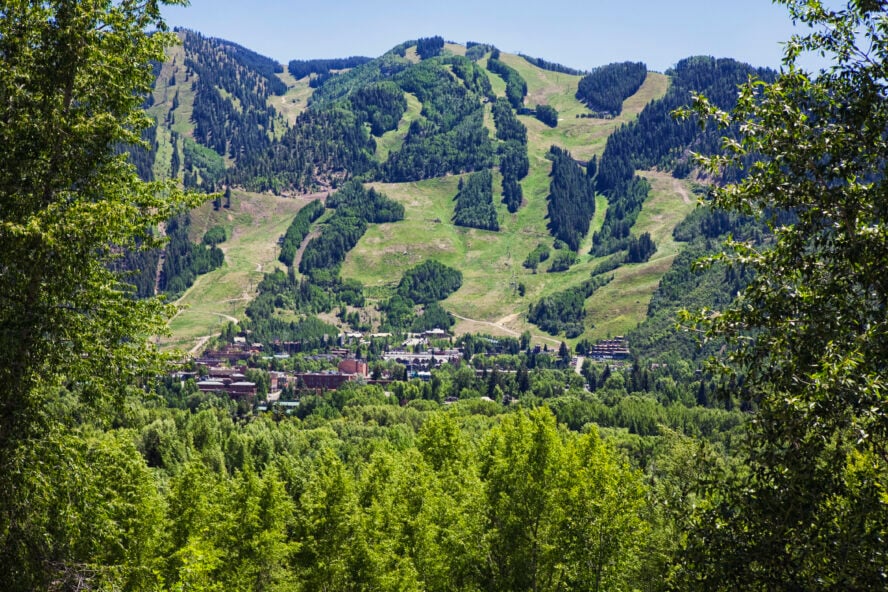
Best Aspen Mountain Biking Trails
The skiers had it right all along — Aspen is well-worth the hype. You’re in for some of the smoothest and speediest singletracks in the state.
Freeride with flow at Aspen Sky Mountain Park
Aspen Sky Mountain contains 15 miles of a singletrack network catering to all skill levels. You won’t get bored since the berms, contours and jumps are really a good time. You also won’t find any rocks — I’ll let you decide if that’s a good thing — because Skyline Trail is made out of mostly smooth shale.
The flowing and fast trails result in a satisfying, non-technical playground. Airline, Cozyline and Viewline trails bring you near the summit with spectacular views of the Elk Mountain Range and sweeping views all the way from Buttermilk to Snowmass.
XC biking trails: Government Trail
Government Trail starts in Snowmass and runs 19 miles before ending at Tiehack Road at the foot of Aspen’s Buttermilk Mountain (perhaps, you’ve heard of X Games?). You can also continue on other trails from Government, but this cross-country trip is an incredible ride all season for taking in the scenery of the Roaring Fork Valley.
The trail takes you across Snowmass Mountain down into the Maroon Creek Valley. Government offers a big payoff of panoramic views after you navigate a technical rock garden like the ones common in Whistler mountain biking. Be aware, the scenery is followed by more than a few pitches. Fortunately, you can plan on catching a ride at Tiehack where there’s usually plenty of free parking. I believe this trail is well worth the effort.
Each year I’ll discover a new trail to get my blood pumping, whether it’s a table or flowy berms. You also don’t have to yearn for monster drops to experience the best of what the area has to offer.
Aspen - Good to Know
Beginner to advanced
Cross country, bik park, singletrack
June to October
Plan ahead: Aspen Mountain Chalet, Difficult Campground
Four Mountain Sports, Ute City, and Aspen Sports Bike Rentals
6. Monarch Crest Trail
Monarch Pass in San Isabel National Forest features a stunning, albeit challenging, high-alpine ride with an atmosphere akin to mountain biking Switzerland. Monarch Crest Trail is one of Colorado’s three IMBA Epic routes starting on the east side of Monarch Pass. Riders ascend 2000 vertical feet and travel above 12,000 feet elevation. The reward is that you’ll enjoy outstanding mountain views in all directions.
The iconic Monarch Crest Trail is actually three trails in one 14-mile point to point, following a section of the Continental Divide Trail. I recommend nabbing a shuttle service for an easy drop off. Otherwise, use two cars and some friends.
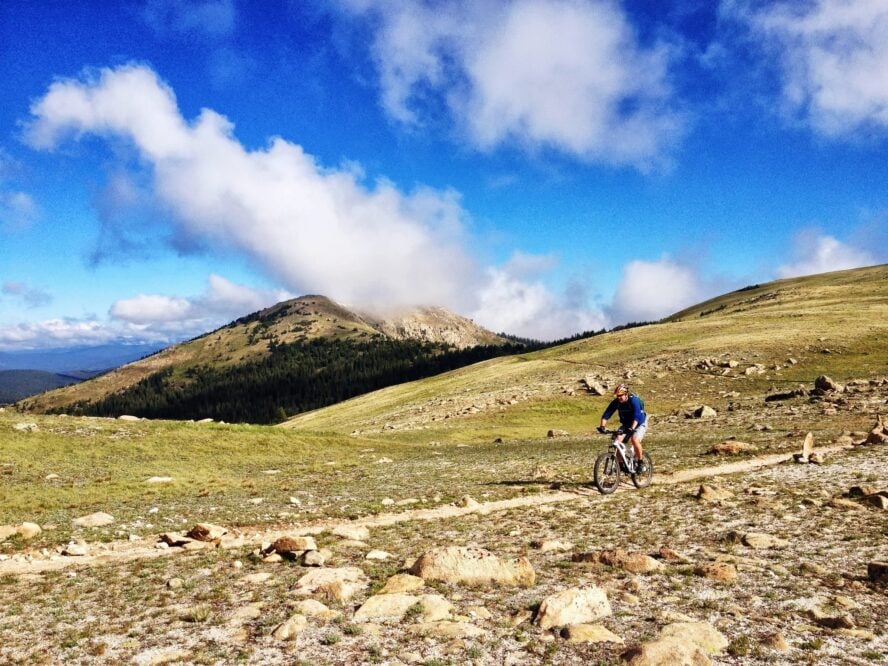
A 15-mile trek with significant climbing up a dirt road will get you onto Monarch Crest Trail. It starts mostly flat and winds through pines before meeting Silver Creek Trail for another 4.5 miles of chundery downhill. You’ll hit some technical terrain, features and vantage points and technical terrain that will make you feel like you’re mountain biking in California.
The trail runs right into the largest section of the ride on the Rainbow Trail for nine miles of additional traversing, climbing and descending, featuring a short rock and root garden climb to start, and a speedy, technical finish. It’s a total of 36 miles back to Poncha Springs, with the last five downhill miles being paved.
How hard is the Monarch Crest Trail?
A challenge is all the eye of the beholder. Climbing 2,000 vertical feet is no joke and takes the majority of the time on this trail. Altitude is also not to be underestimated. Weather can also change at the drop of a hat and lightning is always a risk when traveling in the high country of the Rockies.
Bring layers and start early to avoid afternoon storms, although the changing climate means they’re less of an issue these days. If you’re traveling from sea level or low-elevation areas, do yourself a favor and a day or two to acclimate.
Fortunately, the Arkansas River is a main attraction in Salida and nearby Buena Vista. Plus, you won’t want for dining, shopping, breweries and live-music opportunities in the summer. I recommend you stay in the charming town of Salida, just north of the trail. The trailhead is just 19 miles from Poncha Springs, and another more low-key lodging option.
Find a little bit of everything along this classic track, including doubletrack, singletrack, technical, loose, contoured, and stunning views from above 12,000 feet elevation.
Monarch Crest Trail - Good to Know
Intermediate
A little of everything!
Late June to September
Honorable Mentions
Fruita
One of Colorado’s more renowned MTB destinations, the mountain biking in Fruita is known for its steep climbs, hair-raising switchbacks, and adrenaline-pumping downhills. From the loose technicals of local favorite Lunch Loops to Rabbit Valley’s speedy singletracks, mountain biking tours in Fruita offer a bounty of variety and different flavors.

The Kokopelli Trail System is the highlight here with eight trails of varying difficulty—Rustler’s Loop is a photogenic ride suitable for beginners, albeit with an initial climb, while trails like Moore Fun contain challenging switchbacks, hairpin turns, and rock hair steps that get the heart pumpin’.
The 18 Road Trails, also known as the North Fruita Desert Area, are also well worth a visit thanks to their steep ladders and even steeper chutes. Don’t let the name fool you—the “Chutes and Ladders” trail is not a kid-friendly game.
Durango
The mountain bike tours in Durango contain some of the most high-stakes, high-adrenaline singletracks in the state… along with some pleasant cruises. Yet another mining town turned MTB mecca, it’s a place where dry desert terrain mixes with lush spruce forests, evoking the best mountain bike trails in Moab.
Opened in 2017, the Spur Line Trails host Durango’s premier beginner-friendly terrain. The area is actually made up of two loops: the Switcher Loop—perfect for kids—and the Rail Spikes Loop—with some harder climbs and faster descents, but not overly demanding. It’s a fun and flowy cross-country ride, and the tempo is mild enough to let you enjoy the landscapes.
Engineer Mountain Trail is probably the most popular out here. You can access the trail in several ways, but the trailhead at the top of Coal Bank Pass has the best panoramas. The trail is a straight-forward alpine downhill with the occasional technical section. There are plenty of switchbacks and roots, as well as some rock gardens, but no big mandatory moves. It’s a super flowy ride, and the steeper sections do wonders to spice it up.
Vail Mountain Bike Park
It’s not only a ski resort—Vail Mountain hosts 343 miles of quintessential alpine singletrack through some beautiful meadows. Take one of two available gondolas, Eagle Bahn or Gondola One, straight to the summit, and spend a day exploring Vail’s seven infamous basins, the Back Bowls, or trying some new-school gravity riding.

A day pass will set you back $65 USD ($45 for children, $52 for seniors and the military). There are also plenty of rental spots, as well as packages that include a bike haul plus lunch. The area shines between mid-June and early October, but some north side trails are closed until July, so plan accordingly.
Beaver Creek Resort
Beaver Creek Resort is hands down one of the best bike parks in Colorado. It hosts miles of lift-accessed cross-country singletrack, as well as some easy family-friendly rides with great overlooks. The terrain is rolling and expansive, there are trails for all skill levels, and there are no crowds. Before setting out, keep in mind that the blue trails get pretty challenging—the singletrack can be washed out, rooty, and steep in sections.
The downhill trails are only serviced by a summer lift, but if you’re fit (or cheap) enough, you could ride the 2,000 feet up the mountain. If you need help with the bike, tickets, or planning a ride, contact the good folks at Beaver Creek Sports.
My Advice for Planning Your Colorado Mountain Biking Trip
How to prepare for your trip into Colorado’s wild and open spaces
There are a few tips of advice that seem to trip people up when planning out a trip to Colorado. As anyone who’s ever been hiking in Colorado might tell you, the weather is drastically warmer in the Front Range and Denver area. If you’re headed to the mountains or high elevation, bring a puffy or warm jacket seeing it can get down to the 40s at night, even in the summer.
Ask anyone who did any Front Range climbing and they’ll tell you just how unstable the weather is. The Range and the mountains are known for of-the-moment weather changes, so bring layers or a light jacket. Check the weather often, drink plenty of water and remember altitude lowers your tolerance for alcohol. I’ve seen it too many times where people get wasted after a couple drinks or get headaches from dehydration when visiting Aspen. A reusable water bottle will go a long way.
Remember, more people than ever are heading out into Colorado’s wilderness due travel restrictions. I highly encourage people to explore their own country, state and backyard — all while being a good steward. Pack out all your trash, especially since reduced state and federal park funding means even trash cans aren’t being monitored as well as before. Also, stick to the trails to reduce impact.
How to get to Colorado
If you’re flying from abroad, Denver National Airport is your best (and pretty much only) bet. Denver serves as a gateway to the Front Range, with several shuttle options to Crested Butte, Breckenridge, Aspen, and other spots. It’s also a very bike friendly city, with plenty of well-supplied and affordable rental spots, such as Rocky Mountain Biking.
Alternatively, Colorado Springs Municipal Airport is another good option, especially if you’re renting a car. It’s conveniently located just off Interstate-25, with four-lane access from exit 135, so you’ll hit the road as fast as possible.

Safety tips for encountering and respecting wildlife while biking
Colorado is home to a range of wildlife that live and migrate in the diverse sections of the state. People gravitate here because vast portions of it are wild. That also means you need to be prepared and respect wildlife if you do encounter them.
Certain trails are closed for elk migrations. Black bears aren’t uncommon, and due to the popularity of certain areas where trash is left accessible, interactions are becoming more common. Unlike Alaska’s more dangerous breeds, black bears can be scared away by loud noises. Don’t mess with a mother with her cubs, though.
Moose are infamous for being aggressive, and a mother moose with calves to protect is certainly dangerous. Keep your distance and don’t even dream of a close-up.
Plan wisely or hire a guide before biking in Colorado
Despite its popularity, Colorado’s terrain can pose its own risk and people in the high-alpine can’t be easily reached. Whether you’re new to the sport or have a thousand miles under your tires, it’s always worth considering hiring a MTB guide in unfamiliar terrain. Many of these trails involve stretches of bare rock that are slippery during and after rain, or gravel that can get loose when dry.
Investing in a sturdy mountain bike with good tires and suspension will make a world of a difference. As a beginner, I balked at the gear prices. After one trip to the desert using a borrowed bike without decent tread changed my mind forever.
Pack for weather events — the Rockies get late-afternoon lightning events and the Front Range is notorious for hail storms that will total a car without warning! And bring a GPS, especially if you’re headed into remote areas where you’re unfamiliar. And regardless of the terrain or weather, make sure someone knows where you’re going and when you expect to be back.

